Roman - Others - Sold antiquities
Archive of sold antiquities
All artefacts sold in our gallery are fully documented in our online archive and database. Being a specialist ancient art dealer, preserving also the more recent history of each and every piece sold in our shop is at our heart. That is particularly useful for artefacts that changed owners in the meantime. Information that may have been lost in the process can be easily restored from our archives. Please do not hesitate to contact us if you need further information about ancient items that have been sold in our gallery. We can help you with reconstructing the history of ownership for those items. All information about our customers will be kept confidential, of course.-
 Roman Celtic seal box
Roman Celtic seal boxLozenge shaped body with lid in Celtic design. A piece from the 1st or 2nd century, found near the Celtic settlement and later Roman town of Lindum. Published in a standard work by Richard Hattatt.
Price: on request Roman seal box
Roman seal boxPiriform body with engraved cross on the lid. A piece from the Roman Imperial period. Published in a standard work by Richard Hattatt.
Price: on request Roman seal box
Roman seal boxPiriform body with engraved bird on the lid. A piece from the Roman Imperial period, found near Dover. Published in a standard work by Richard Hattatt.
Price: on request Roman seal box with phallus
Roman seal box with phallusCircular body with protective phallus in high relief on the lid. A piece from the Roman Imperial period, found in North East England. Published in a standard work by Richard Hattatt.
Price: on request Four Roman bronze artefacts from Novaesium
Four Roman bronze artefacts from NovaesiumTwo handles, one of them beautifully incised. And one arrow head and an amulet. Finds from the Roman city of Novaesium, today's Neuss in Germany.
Price: on request Roman lock bolts from Novaesium
Roman lock bolts from NovaesiumPart of a key lock, e.g. for a door or chest. Finds from the Roman city of Novaesium, today's Neuss in Germany.
Price: on request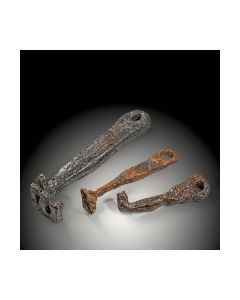 Three Roman iron keys from Novaesium
Three Roman iron keys from NovaesiumIron keys of typical shape. Finds from the Roman city of Novaesium, today's Neuss in Germany.
Price: on request Roman bronze chain
Roman bronze chainFox tail type chain fragment. A Find from the Roman city of Novaesium, today's Neuss in Germany.
Price: on request Base plate of a Roman mirror
Base plate of a Roman mirrorThe bronze disc is the base plate of a Roman mirror. A handle and reflective metal coating were once part of the mirror. Typical for upper class Roman households during Imperial times.
Price: on request Roman gaming pieces from the Rhineland
Roman gaming pieces from the Rhineland6 Roman glass gaming pieces and 8 other Roman artefacts. Finds from the Roman city of Novaesium, today's Neuss in Germany.
Price: on request Eight Roman bronze artifacts
Eight Roman bronze artifactsVarious artifacts in different states of preservation. Finds from the Roman city of Novaesium, today's Neuss in Germany.
Price: on request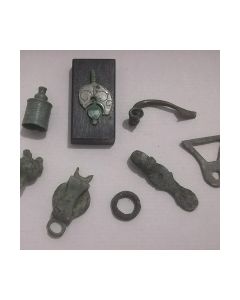 Eight Roman bronze artefacts
Eight Roman bronze artefactsVarious artefacts in different states of preservation. Finds from the Roman city of Novaesium, today's Neuss in Germany.
Price: on request Two Roman potsherds from the Rhineland
Two Roman potsherds from the RhinelandFragments of Roman pottery. Finds from the Roman city of Novaesium, today's Neuss in Germany.
Price: on request Late Roman votive mirror
Late Roman votive mirrorExceedingly rare in this state of preservation, including remains of the original glass and reflective lead foil.
Price: on request Roman mirror from Baalbek
Roman mirror from BaalbekThe bronze disc is the base plate of a bronze mirror, that was once attached to a handle and coated with a reflective metal layer. Typical for upper class Roman households during Imperial times.
Price: on request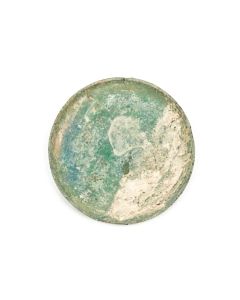 Roman mirror from Baalbek
Roman mirror from BaalbekThe bronze disc is the base plate of a bronze mirror, that was once attached to a handle and coated with a reflective metal layer. Typical for upper class Roman households during Imperial times.
Price: on request Roman military whistle
Roman military whistleHistorically interesting example of Roman military equipment. Whistles of this type have been used in the 1st to 2nd cent. AD. Their function is not fully understood, yet.
Price: on request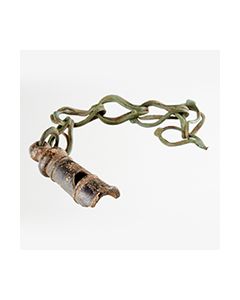 Roman military whistle
Roman military whistleHistorically interesting example of Roman military equipment. Whistles of this type have been used in the 1st to 2nd cent. AD. Their function is not fully understood, yet.
Price: on request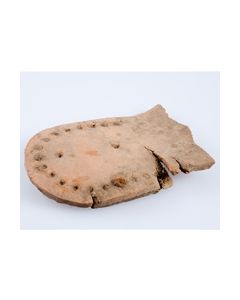 Fragment einer römischen Schuhsohle
Fragment einer römischen SchuhsohleHintere Hälfte einer römischen Schuhsohle. Seltenes Fundstück aus einem römischen Militärlager, von römischen Caligae, den typischen Militärsandalen der Legionäre.
Price: on request Paar römischer Würfel
Paar römischer WürfelZwei römische Würfel aus Bein, etwa 3. bis 4. Jhd.n.Chr., aus röm. Provinz Pannonia. Vermutlich Eigentum von Soldaten.
Price: on request Paar römischer Würfel
Paar römischer WürfelZwei römische Würfel aus Bein, etwa 3. bis 4. Jhd.n.Chr., aus röm. Provinz Pannonia. Vermutlich Eigentum von Soldaten.
Price: on request Paar römischer Würfel
Paar römischer WürfelZwei römische Würfel aus Bein, etwa 3. bis 4. Jhd.n.Chr., aus röm. Provinz Pannonia. Vermutlich Eigentum von Soldaten.
Price: on request Römischer Würfel
Römischer WürfelEin römischer Würfel aus Bein, etwa 3. bis 4. Jhd.n.Chr., aus röm. Provinz Pannonia. Vermutlich Eigentum von Soldaten.
Price: on request Paar römischer Würfel
Paar römischer WürfelZwei römische Würfel aus Bein, etwa 3. bis 4. Jhd.n.Chr., aus röm. Provinz Pannonia. Vermutlich Eigentum von Soldaten.
Price: on request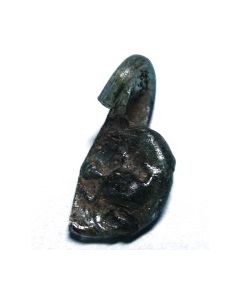 Fragment eines Anhängers mit Schildkrötendarstellung
Fragment eines Anhängers mit Schildkrötendarstellung1. Jh. v. Chr. bis 7. Jh. n. Chr., römisch bis byzantinisch. Hell-grünes, schön durchscheinendes Glas. Patiniert. Durchmesser 13mm, Länge22mm. 0,82g.
Price: on request Paar römischer Würfel
Paar römischer WürfelZwei römische Würfel aus Bein, etwa 3. bis 4. Jhd.n.Chr., aus röm. Provinz Pannonia. Vermutlich Eigentum von Soldaten.
Price: on request Paar römischer Würfel
Paar römischer WürfelZwei römische Würfel aus Bein, etwa 3. bis 4. Jhd.n.Chr., aus röm. Provinz Pannonia. Vermutlich Eigentum von Soldaten.
Price: on request Paar römischer Würfel
Paar römischer WürfelZwei römische Würfel aus Bein, etwa 3. bis 4. Jhd.n.Chr., aus röm. Provinz Pannonia. Vermutlich Eigentum von Soldaten.
Price: on request Paar römischer Würfel aus weißem Bein
Paar römischer Würfel aus weißem BeinPaar römischer Würfel aus weißem Bein, selten. Vermutlich Eigentum von Offizieren.
Price: on request Bandelierbesetzung eines römischen Legionärs
Bandelierbesetzung eines römischen LegionärsBronzerosette, römische Militärdekoration. 3. Jh. n.Chr., gute Erhaltung. 27mm Durchmesser.
Price: on request Diverse römische Bronzeartefakte
Diverse römische BronzeartefakteFingerring und Teile römischer Militärausrüstung. 1. bis 4. Jh. n.Chr., römische Epoche. Germania Inferior.
Price: on request Vergoldete römische Gürtelschnalle
Vergoldete römische GürtelschnalleGürteldekoration oder -schnalle, vergoldete Bronze, 1. bis 3. Jh. n.Chr, pannonische Provinzen. In sehr schöner Erhaltung. 47mm x 21mm.
Price: on request Gruppe diverser römischer Befestigungen
Gruppe diverser römischer BefestigungenDiverse Befestigungen und Aufhängungen, vermutlich Teil römischer Militärausrüstung. Möglicherweise Zelthaken (oben). 1. bis 4. Jh. n.Chr., römische Epoche. Germania Inferior.
Price: on request Diverse römische Artefakte
Diverse römische ArtefakteNicht näher bestimmte Artefakte, vermutlich Zubehör für römische Militärausrüstung. 1. bis 4. Jh. n.Chr., römische Epoche. Germania Inferior.
Price: on request Diverse römische Artefakte
Diverse römische ArtefakteNicht näher bestimmte Artefakte, könnten Teil römischer Militärausrüstung sein. 1. bis 4. Jh. n.Chr., römische Epoche. Germania Inferior.
Price: on request Knöpfe von einer römischen Militärausrüstung
Knöpfe von einer römischen MilitärausrüstungDiverse Typen. 1. bis 4. Jh. n.Chr., römische Epoche. Germania Inferior.
Price: on request

